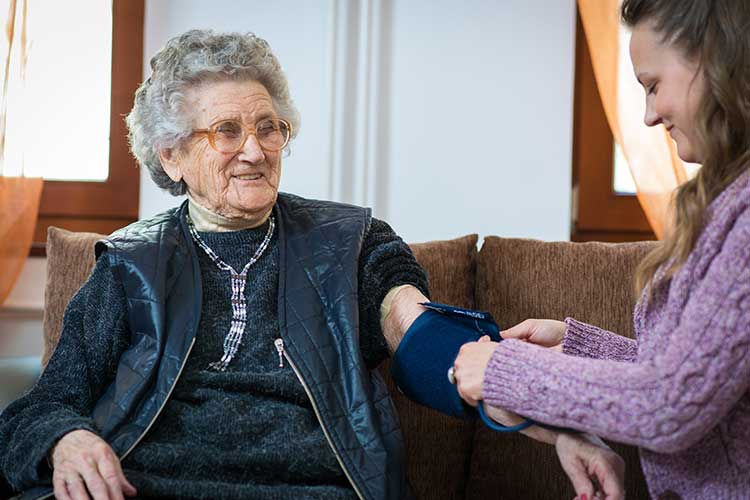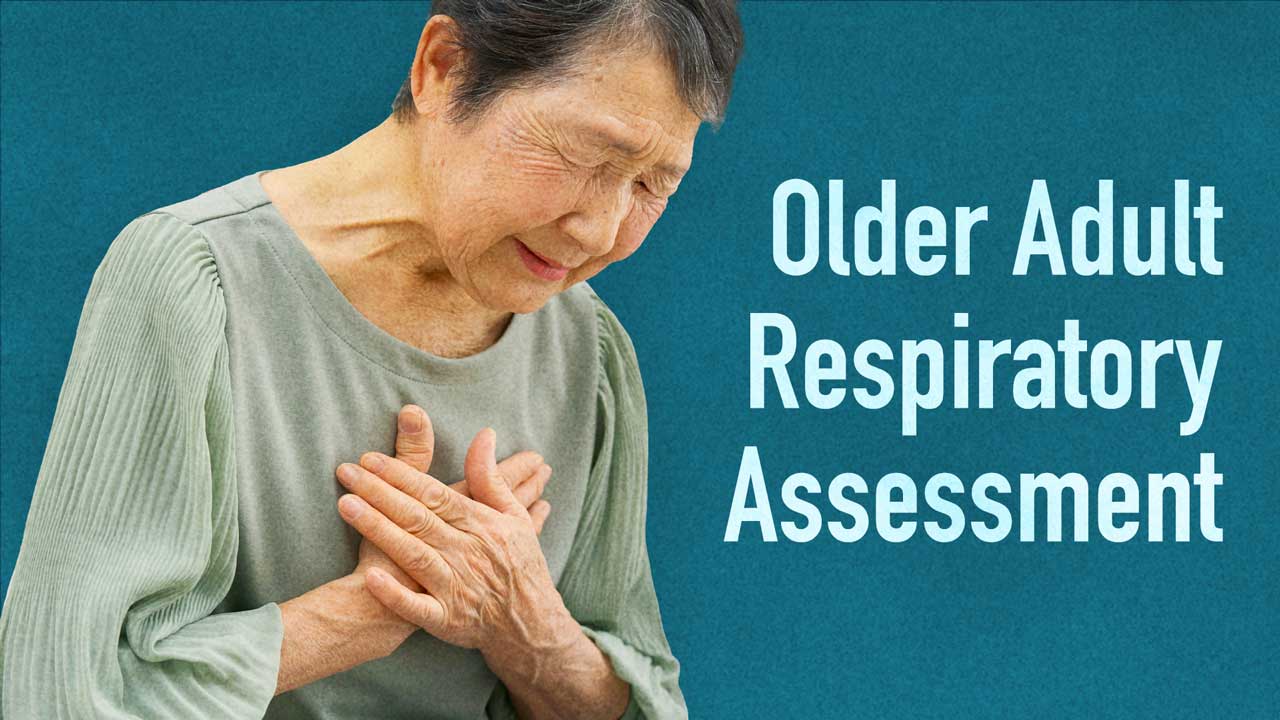When presented with a critically ill patient, it is crucial to conduct a systematic assessment of that person in order to identify and respond appropriately to any potentially life-threatening conditions (Smith & Bowden 2017).
When conducting a respiratory assessment, it is important to monitor changes in vital signs in order to recognise a deteriorating patient. You need to be familiar with what is normal so that you can distinguish what is abnormal (ACSQHC 2024).
Although the assessment procedure for older adults is similar to the one used for younger adults, there are some physiological differences between the two age groups that should be considered.
Older Adult Respiratory and Heart Rates
Generally, breathing and heart rates (resting) do not change much with age (MedlinePlus 2024). For a healthy, average adult, the normal rates are:
- Respiration: 12 to 20 breaths per minute
- Heart rate: 60 to 100 beats per minute.
(Sapra et al. 2023)

How are Older Adults Different to Younger Adults?
Although vital signs do not change much with age, there is a gradual decline of lung function over time, starting from about the age of 35 (American Lung Association 2018).
The following are some of the physical changes related to ageing that may cause lung function decline:
- Alveoli may lose shape and become baggy
- The diaphragm weakens
- The ribcage bones become thinner and change shape, making it more difficult for them to expand and contract
- Nerves in the airway become less sensitive to foreign particles, meaning particles may collect in the lungs and cause tissue damage.
(American Lung Association 2018)
These changes may cause tiredness or shortness of breath. Furthermore, a weaker immune system means older adults are more susceptible to developing pneumonia (American Lung Association 2018).
These changes are natural over time, however, they should be gradual and subtle. Sudden changes should be assessed by a healthcare professional (American Lung Association 2018).
Causes of Respiratory Distress in Older Adults
- Upper respiratory infections such as croup and influenza
- Lower respiratory infections such as pneumonia and bronchitis
- COVID-19
- Lung problems such as asthma and COPD
- Heart problems such as cardiovascular disease and heart failure
- Panic attack or anxiety
- Allergic reaction
- Pulmonary embolism
- Other lung conditions.
(Healthdirect 2023)

Symptoms of Respiratory Distress
- Increased respiratory rate
- Colour changes (cyanosis or pallor)
- Noises such as stridor, wheezing or grunting
- Nose flaring
- Retractions of the chest where it appears to sink in below the neck or breastbone with each breath
- Sweating
- Accessory muscle use
- Changes in consciousness state
- Body position changes (e.g. leaning forward while sitting).
(Johns Hopkins Medicine 2019; Resuscitation Council UK 2024)
If the older adult has a cognitive impairment such as dementia, it may be difficult for them to communicate, especially in emergency situations. Therefore, it is crucial to assess for the physical symptoms above in case the patient is not able to verbalise their needs.
Assessment of Respiratory Distress
Early recognition of respiratory distress and deficit is vital to the successful management of sick patients and the prevention of further deterioration or arrest. In order to manage respiratory distress, it is important to have a systematic approach to assessment (Smith & Bowden 2017).
The ABCDE approach - Airway, Breathing, Circulation, Disability and Exposure - is a simple and effective method of assessment.
When assessing the airway, you should consider the following:
- Is there airway patency?
- Are there any signs of airway obstruction?
- Is breathing overly noisy or silent?
- Is the patient breathing paradoxically or using accessory muscles?
(Resuscitation Council UK 2024)
When assessing the breathing, you should consider the following:
- Is the patient displaying any general signs of respiratory distress e.g. sweating, central cyanosis, use of accessory muscles or abdominal breathing?
- What is the respiratory rate?
- Assess the depth of each breath, the respiration rhythm and whether chest expansion is equal on both sides
- Assess whether there is any chest deformity e.g. raised jugular venous pulse or abdominal distension.
(Resuscitation Council UK 2024)
Refer to How To Assess a Deteriorating / Critically Ill Patient (ABCDE Assessment) for a comprehensive explanation of the ABCDE assessment process.
Always Remember

You need to be aware of what is normal before you can recognise what is abnormal. It’s helpful to establish a baseline to compare progress or deterioration. Use a systematic approach, such as the ABCDE approach.
The goal of assessment is not to make a diagnosis but to identify a deteriorating patient and respond to the symptoms in order to prevent arrest. Consider oxygen, suction and medication depending on the assessment (Resuscitation Council UK 2024).
Following the initial assessment (and resuscitation if required), a secondary structured assessment should be undertaken to identify any other key signs or symptoms (Resuscitation Council UK 2024).
When assessing the airway, the life threat to identify is airway obstruction. This is a medical emergency that may result in hypoxia, damage to the brain, kidneys or heart, cardiac arrest or death. It requires prompt management so that the patient can be oxygenated (Resuscitation Council UK 2024).
Test Your Knowledge
Question 1 of 3
After about what age does lung function begin to naturally decline?
Topics
Further your knowledge
 Free
Free
 Free
FreeReferences
- American Lung Association 2018, ‘Your Aging Lungs’, Each Breath, 24 April, viewed 1 April 2025, https://www.lung.org/blog/your-aging-lungs
- Australian Commission on Safety and Quality in Health Care 2024, Detecting and Recognising Acute Deterioration, and Escalating Care, Australian Government, viewed 1 April 2025, https://www.safetyandquality.gov.au/standards/nsqhs-standards/recognising-and-responding-acute-deterioration-standard/detecting-and-recognising-acute-deterioration-and-escalating-care
- Healthdirect 2023, Shortness of Breath, Australian Government, viewed 1 April 2025, https://www.healthdirect.gov.au/breathing-problems
- Johns Hopkins Medicine 2019, Signs of Respiratory Distress, The Johns Hopkins University, viewed 1 April 2025, https://www.hopkinsmedicine.org/health/conditions-and-diseases/signs-of-respiratory-distress
- MedlinePlus 2024, Aging Changes in Vital Signs, U.S. Department of Health and Human Services, viewed 1 April 2025, https://medlineplus.gov/ency/article/004019.htm
- Resuscitation Council UK 2024, The ABCDE Approach, Resuscitation Council UK, viewed 1 April 2025, https://www.resus.org.uk/library/abcde-approach
- Sapra, A, Malik, A & Bhandari, P 2023, ‘Vital Sign Assessment’, StatPearls, viewed 1 April 2025, https://www.ncbi.nlm.nih.gov/books/NBK553213/
- Smith, D & Bowden, T 2017, ‘Using the ABCDE Approach to Assess the Deteriorating Patient’, Nursing Standard, vol. 32, no. 14, viewed 1 April 2025, https://journals.rcni.com/nursing-standard/using-the-abcde-approach-to-assess-the-deteriorating-patient-ns.2017.e11030
 New
New 
